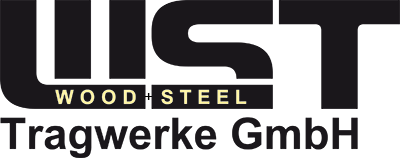A real HTS Hybrid Beam
Unique Selling Points
In comparison to glulam beams, solid wood or other beams with wood sections, the thin corrugated steel of HTS Hybrid Beams provides better heat insulation properties.
It always makes sense to use HTS hybrid beams for systems with larger spans.
The beam is second to none for spans of 8 to 18 m.
When used as horizontal purlins in the construction of halls spanning up to 12 m, every second hall frame and every second base can be dispensed with, or for the construction of offices or residential buildings with pitch or flat roofs where the top storey load-bearing interior walls are going to be omitted – then HTS Hybrid Beams are the best solution.
When used for the ceiling boxing in system building constructions, HTS is an excellent choice due to its high rigidity. The well-known problem of “swing” of ceiling boxes with a span around 5 m as a single span beam is solved with HTS.
For support-free carports and storage halls with a max. span of 12 m span and a ceiling-like roof construction, the low weight of the beams simplifies installation as elaborate lifting equipment is no longer needed.
The HTS system is a connected system that yields. When the beam is loaded, the yield causes relative displacement between the interconnected single cross sections. Sections which are straight in an unloaded condition, are no longer straight in a loaded condition, but display an offset. This means failure of the beam “without notice” in the event of overload is therefore excluded. (A possibility for other systems.)
Not only the low weight, but also the slenderness of the beams has structural advantages. In addition, the insulation performance, for instance of a roof with HTS, is better than for glulam beams or even solid timber. Even without rafter insulation, an excellent insulation is achieved.
Other reasons to use HTS beams:
Timber is perfectly suited for transmitting tensile and compressive stresses in the direction of the wood fibers. The upper and lower flanges of the HTS absorb the forces. The shear flow between the flanges is absorbed by one or two parallel steel web bridges. For shearing stress, steel is the better choice. Consequently, our beam, in comparison to double-T beams from solid timber, is designed to have a higher overall stiffness and is substantially distortion-free.
The galvanized steel core (high corrosion protection) of the HTS has a lower vibration performance than solid timber. This also has a positive effect on acoustics.
Safety
Some of the most successful sales products of our partners in recent years have been the prefabricated roof, ceiling and wall elements for, e.g. supermarkets, office buildings, kindergartens, schools and residential buildings. The elements have dimensions up to 2.50 x 18.00 m. Four HTS beams are fitted on both sides with OSB boards and the cavity is filled with insulation. The element is finished with an underlay sheet (rain protection). These elements can be used to construct a roof of 1,200 m2 in a single day. Fire protection cladding and/or sound-absorbing surface can be added internally. A load of approximately 1.0 kN/m2 can be expected for the load transfer of the false ceiling.
The upper and lower flanges
Upper and lower flanges are a key structural feature, made from Fi/Ta softwood timber grade S10 as stipulated by DIN 4074 (NSI Quality) kiln-dried to a moisture content of 15% +- 3% dovetailed as stipulated by DIN 68140, planed on 4 sides, edges blunted, or alternatively made from Mark Brandenburg construction pine.
The visible bottom flanges of the roof elements of one-storey buildings can be finished with an open-pore coating to be a visually arresting element of the design.
The corrugated steel web and its benefits
The steel bridge shaft is made of galvanized materials in the S550 GD + Z quality assurance coatings class as stipulated by DIN EN 10147 1995 – 08.
The steel grade complies with the requirements of building regulations.
The zinc coating is at least 275 g/m2. The corrosion performance of hot-dip galvanized surfaces under different corrosion conditions is divided into the categories C1 to C4.
C3 is sufficient for high humidity, average external air pollution: industrial or urban atmosphere or coastal climate with low chloride content.
Under normal indoor conditions, a durability of 50 to 100 years is to be expected.
In comparison to the paint finishes, galvanizing has the following advantages:
- much better resistance to mechanical stress
- the cathodic protection effect means that for minor surface damage no corrosion spots result
- no infiltration/displacement possible.
The new steel corrugated web represents an innovative opportunity, making HTS hybrid beams more economical and stronger than ever before.
The corrugated steel web
Steel web profile corrugated in galvanized primary material of grade S 550 GD + Z as stipulated by DIN EN 10147 1995-08 n/mm2, trapezoidal, one or two 0.5 mm webs of special steel, minimum yield strength 550 n/mm2. The zinc coating has a density of at least 275 g/m2, giving a better anti-corrosion finish than the painted coatings, especially for agricultural uses.
In terms of thermal bridges, our thin steel is advantageous in comparison to solid timber and glulam.
